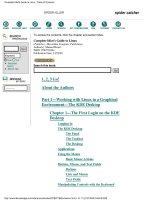Tài liệu The Insider’s Guide to PR: Chapter 7 A GLOSSARY OF PR SPEAK doc
Bạn đang xem bản rút gọn của tài liệu. Xem và tải ngay bản đầy đủ của tài liệu tại đây (200.57 KB, 2 trang )
A GLOSSARY OF PR SPEAK
• Above-the-line campaign: a marketing campaign using only advertising.
• Account: the term used to describe a client or job. In consultancies, “an account
team” refers to the group of PR consultants servicing a particular client.
• Below-the-line campaign: a marketing communications campaign that does not
use advertising. Instead it uses promotional tools such as public relations, direct
marketing and sales promotion.
• Brief: the instructions from a client to a consultancy, or directions communicated
within a PR agency.
• Broadcast: the dissemination of programmes or messages through the media of
radio, internet or television.
• Brainstorming: the creative process of group thinking to stimulate or articulate
ideas on a given subject or problem.
• Client: the organisation or person who employs a PR consultancy.
• Clipping: see Cutting.
• Communication: the credible, honest and timely two-way flow of information
that fosters common understanding and trust.
• Competition: other organisations that represent a threat to a particular business.
• Contract: an agreement made between the PR consultancy and the client
covering areas of agreed objectives, timing, service levels and price.
• Copy: the text produced by a consultancy for a press release or article. Journalists
also refer to their news stories or features as copy.
• Corporate Communication: deliberately planned management of the
communications affecting the perception and image of an organisation.
• Crisis Management: this involves planning and preparing a client for any possible
crisis that is likely to affect the organisation, and how it should communicate to
all its stakeholders during that crisis. This involves training relevant
spokespeople, co-ordinating crisis recovery activities and ensuring a unified,
confident and controlled public image. Crisis management is closely related to
issues management.
• Cue sheet: briefing notes to help a spokesman prepare for an interview with a
journalist. The cues should cover the issues that are likely to arise in the interview
and the approach that should be taken on these issues.
• Cutting: the piece of written material containing messages about the client or its
products or an extract from a paper or magazine regarding a particular account.
Also commonly referred to as ‘clipping’.
• E-pr: the practice of public relations using the internet instead of, or alongside,
traditional media.
• Editorial: written materials composed to communicate a brand to the various
audiences identified by the client and consultancy.
• Embargo: a warning to the media not to publish a news item until the date
specified on the release (usually appears at top of first page of news release or
statement). Journalists usually honour this unofficial agreement.
• Evaluation: measurement of the agreed objectives set by the consultancy and
client prior to the start of an agreed activity like a media relations campaign. The
results of the evaluation are used for future planning and development of the
ongoing PR strategy and to benchmark against overall objectives.
• Exposure: the extent to which the target audience becomes aware of a person,
message, activity, theme or organisation through the efforts of PR. This might be
used as part of the evaluation process.
• Exclusive: a news story offered by a PR practitioner to a single newspaper title,
radio, website, or TV station.
• Feature article: a broad or in-depth newspaper, magazine, internet, radio or TV
article that discusses, analyses or interprets an issue, subject or trend. A feature
generally takes longer to research and produce than a news story.
The Insider’s Guide to PR: Chapter 7
Page 19
• Financial PR: the efforts of a publicly-held company, or one that is on the way to
a public flotation, to communicate with shareholders, security analysts,
institutional investors and stock exchanges.
• Full Service: a one-stop PR shop which incorporates clients from many different
industry sectors and which offers a range of PR disciplines, and sometimes in-
house design and other services.
• Healthcare PR: specialist PR discipline that communicates about either
prescription only (ethical healthcare) or OTC (over-the-counter) products or
issues, to medical groups, interested third parties or specialist media.
• Integrated campaign: a multidisciplinary approach which uses a number of
marketing communications techniques in order to deliver a consistent set of
messages. The aim is to achieve seamless communication with the audience.
• Internal Communications: information dissemination and flow between an
organisation and its employees. Common tools include newsletters and intranets.
• Logo: A graphic or symbol owned by and representing a company or brand.
• Media Relations: communicating with the media by pro-actively speaking to
journalists and sending out relevant articles to the respective publications,
responding to media enquiries, and providing appropriate information on behalf
of an organisation.
• Messages: agreed words or statements that a client wants to convey to third
parties, like the media or shareholders for example.
• News Release: a written communication sent to all news media. Also known as a
press release.
• Media: channel for the communication of information including newspapers,
magazines, radio, TV, mobile phones and the internet.
• News Conference: the live dissemination of news information by an organisation
to invited media. The format is usually a presentation of information by the
organisation followed by a question and answer session.
• Pitch: when PR consultancies are invited by a prospective client to propose how
they would tackle a given brief.
• Press Pack/Kit: a branded pack handed out to the media by an organisation. It
normally contains background material, photographs, illustrations and news
releases.
• Press Release: see News Release.
• Proposal: document outlining a proposed PR campaign to an existing or potential
client.
• Public Affairs - the process of communicating an organisation’s point of view on
issues or causes to political audiences like MPs and lobbying groups.
• Regulatory News Service(RNS) - RNS is an online application which allows listed
companies or their Advisers to submit announcements to investors and
intermediariaries through the London Stock Exchange.
• Search engines: these allow you to search the contents of the world wide web.
When you key in a search term, you receive a list of items that match your query.
• Sector/trade press: the media relevant to specific audiences. This includes special
interest magazines such as hi-fi magazines for hi-fi enthusiasts. Trade journals are
read for business and professional reasons, for example Electronics Week is read by
electronics engineers.
• Teaser: a promotion that is intended to arouse interest in the main campaign
which follows. It is usually used in media relations.
• Transcript: written outline of a radio or TV broadcast about a client.
• Vertical media: media relating to different market sectors for a product or service.
For example, you can promote a barcode printer in the printing media, packaging
media and food retailing media.
• Viral campaign: a communications campaign which is designed to exploit the
potential of the internet to spread messages rapidly. The audience is encouraged
to pass a message on to all their email contacts.
With special thanks to Fiona Campbell, Senior Lecturer, West Herts College.
The Insider’s Guide to PR: Chapter 7
Page 20









